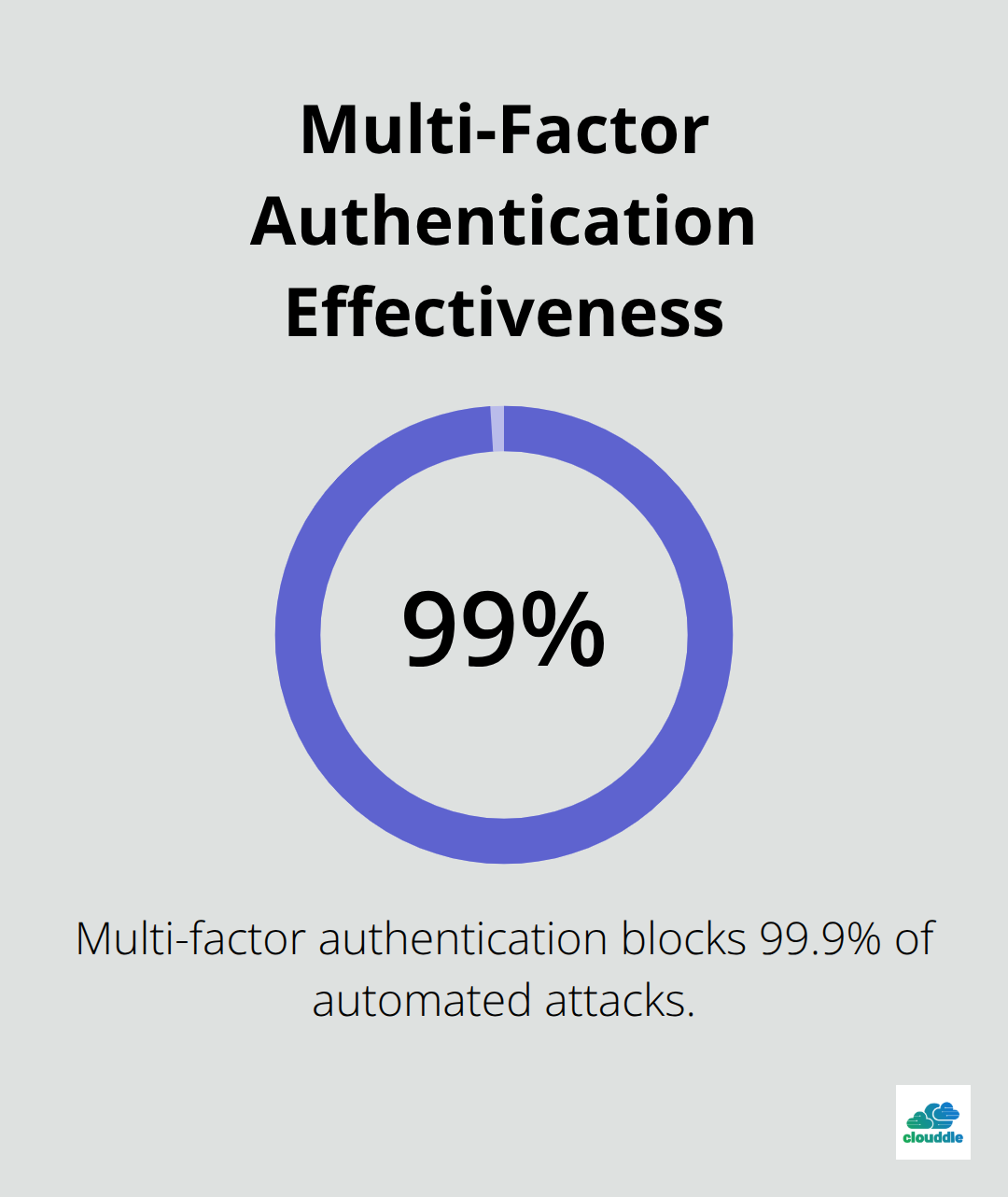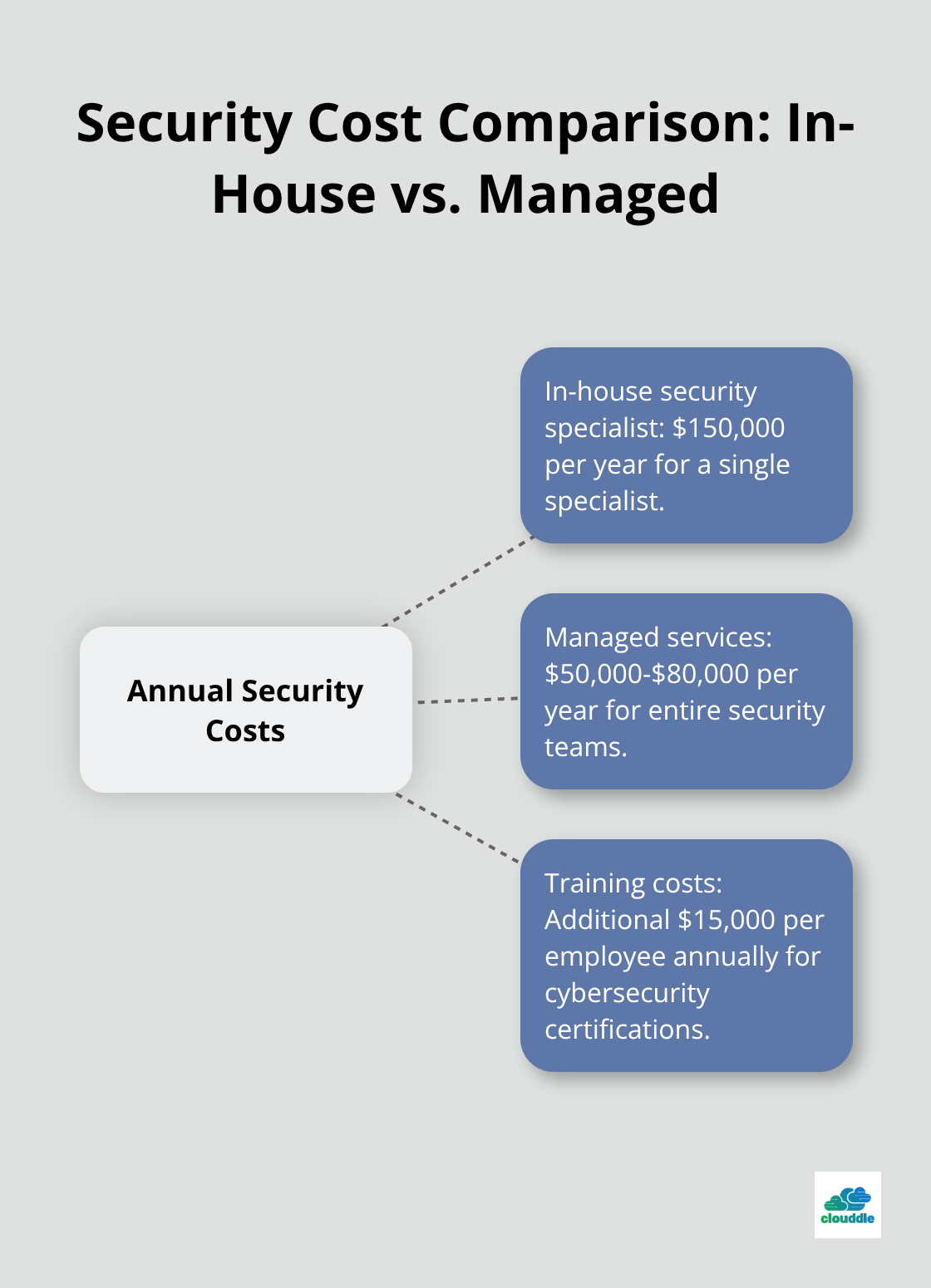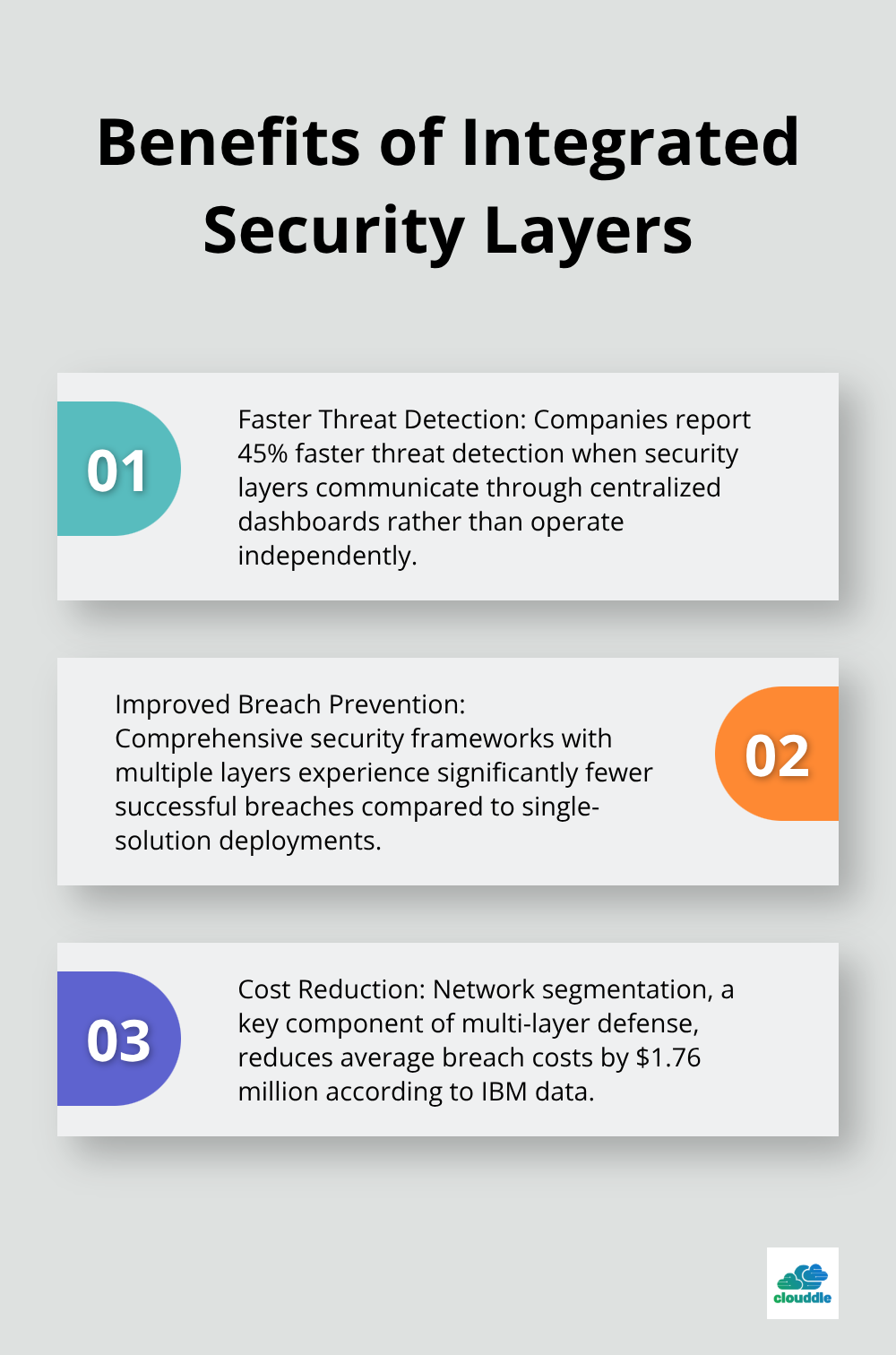Network attacks cost businesses an average of $4.45 million per breach in 2023, according to IBM’s Cost of a Data Breach Report. The network security benefits extend far beyond preventing financial losses.
At Clouddle, we see companies transform their operations when they implement comprehensive security strategies. Strong network protection drives business growth while reducing operational risks.
What Business Benefits Does Network Security Actually Deliver?
Network security transforms operations in three measurable ways that directly impact your bottom line. Companies with robust security frameworks experience 23% fewer system downtimes and 67% faster incident response times according to Ponemon Institute research. Your network becomes the foundation for reliable operations rather than a vulnerability that threatens business continuity.
Threat Prevention That Actually Works
Modern businesses face significant cyber threats, with 43% of attacks targeting small businesses who are seen as easy prey due to weaker security measures. Multi-factor authentication alone blocks 99.9% of automated attacks, while network segmentation reduces breach costs by an average of .76 million per incident (based on IBM’s 2024 findings). Your security investment pays for itself through prevented losses rather than recovery expenses.

Performance Gains Through Security
Properly configured firewalls and intrusion prevention systems improve network speeds by 15-30% while they block threats. Security tools like bandwidth monitoring and traffic analysis identify bottlenecks before they impact productivity. Companies report 40% fewer IT support tickets after they implement comprehensive security monitoring, which frees technical teams for strategic projects.
Customer Retention Through Trust
Data breaches significantly impact customer trust, with 58% of consumers indicating breaches affected their trust in 2024. However, companies that proactively communicate their security measures see 28% higher customer satisfaction scores. Your security posture becomes a competitive advantage when customers choose providers they trust with sensitive data over cheaper alternatives with questionable protection.
These measurable benefits create the foundation for smart security investments. The next step involves choosing between managed services and in-house solutions to maximize your return on investment.
Which Security Strategy Actually Saves Money?
Managed security services have shown significant growth, with an 11.5% increase outpacing other security consulting services. Companies spend an average of $150,000 annually on a single security specialist, while managed services provide entire security teams for $50,000-$80,000 per year. The math becomes even more compelling when you factor in training costs (which average $15,000 per employee annually for cybersecurity certifications). Managed providers also respond to incidents 3x faster than internal teams because they monitor threats around the clock across multiple clients.

Smart Budget Allocation Beats Expensive Tools
Small businesses achieve 85% of enterprise-level protection when they use free tools like Windows Defender, pfSense firewalls, and OpenVPN instead of premium solutions that cost $50,000+ annually. Splunk alternatives like Elastic Stack provide similar log analysis capabilities at zero license cost. However, configuration matters more than price tags. Companies that use properly configured budget tools experience 70% fewer successful attacks than those with expensive but poorly implemented solutions (according to SANS Institute data). Focus your spending on professional configuration rather than premium license fees.
Security Investment Returns Peak Within 18 Months
Proactive security investments generate significant ROI through avoided breach costs and reduced downtime. The latest Forrester study reveals a 242% ROI over three years for organizations implementing comprehensive security solutions. The calculation becomes straightforward when you compare prevention costs against IBM’s $4.88 million average breach cost. Organizations also save 25-40% on cyber insurance premiums when they demonstrate strong security controls to insurers.
These financial benefits multiply when you implement the right security practices. The most effective approach combines multiple security layers with comprehensive employee education programs.
How Do You Build Security That Actually Works?
Security architecture success depends on three specific layers that work together rather than single-point solutions. The foundation layer includes next-generation firewalls with deep packet inspection, network segmentation that isolates critical systems, and endpoint detection response tools on every device. Companies with comprehensive security frameworks experience significantly fewer successful breaches compared to single-solution deployments. The middle layer adds identity access management with zero-trust principles, where every user and device requires verification regardless of location. The top layer implements security information and event management systems that correlate threats across all security tools.
Multi-Layer Defense Architecture
Companies report 45% faster threat detection when security layers communicate through centralized dashboards rather than operate independently. Next-generation firewalls must inspect traffic at the application layer, not just ports and protocols. Network segmentation creates isolated zones that prevent lateral movement during breaches (reducing average breach costs by $1.76 million according to IBM data). Endpoint detection tools monitor device behavior in real-time and automatically quarantine suspicious activities before they spread across networks.

Transform Employees Into Your Strongest Defense
Employee security training must focus on specific attack scenarios rather than generic awareness sessions. Phishing simulation programs that test employees monthly reduce successful attacks, with studies showing 9.5% reduction in phishing failures compared to control groups. Training should cover social engineering tactics, password management with dedicated tools like Bitwarden or 1Password, and incident response procedures that employees actually follow. Companies achieve the best results when they make security training mandatory quarterly and track completion rates through management systems.
Security Audits Prevent Expensive Problems
Vulnerability assessments must happen monthly for internet-facing systems and quarterly for internal networks to catch threats before attackers exploit them. Automated tools like Nessus or OpenVAS identify 95% of common vulnerabilities, but manual penetration tests find the remaining 5% that cause major breaches. The National Institute of Standards and Technology recommends annual third-party security audits for complete coverage. Companies that conduct regular assessments spend 40% less on incident response because they fix problems during maintenance windows instead of emergency situations.
Final Thoughts
Network security benefits extend far beyond threat prevention to drive measurable business growth. Companies that implement comprehensive security strategies see 23% fewer downtimes, 67% faster incident response, and 242% ROI within three years. The financial impact becomes clear when you compare prevention costs against the $4.88 million average breach expense.
Multi-layer architecture that combines firewalls, network segmentation, and endpoint protection provides the strongest foundation. Monthly employee training through phishing simulations and quarterly vulnerability assessments catch threats before they cause damage. Managed services deliver enterprise-level protection at 60% lower costs than expensive in-house teams.
Zero-trust principles and automated monitoring systems provide the foundation for scalable security that grows with your business. Clouddle offers Network as a Service solutions that combine networking, security, and 24/7 support without upfront investment. Network security benefits compound over time through improved customer trust, reduced insurance premiums (up to 40% savings), and competitive advantages in markets where data protection matters most.


